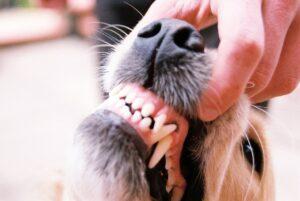Brushing your pet’s teeth regularly is a great way to keep their gums and teeth healthier and fight gum disease. The best way to introduce this routine is gradually which will mean they (and you!) will learn to enjoy the experience. If your pet already has brown staining on their teeth, brushing will not remove this. The only way to remove this tartar is by a dental scale & polish which requires a general anaesthetic.
What you will need:
* A tooth brush with medium bristles and the correct size. You should use an adult size toothbrush for a medium or large dog, a child’s brush for small dogs and a special pet tooth brush for a toy or miniature dog
* Pet toothpaste
* A quiet place without distractions
* A little time and a bit of patience!
Tips before you start:
* Take care when putting your fingers in your pet’s mouth. We don’t recommend doing this if your pet is likely to bite or become aggressive.
* Keep the session short.
* Pick a time which suits your daily routine.
* Try to keep to the same time every day.
* Repeat each stage daily until your pet is comfortable with it and then continue for a few more days beyond that.
* Train at a pace that suits your pet. It is ok to go back a step.
* Give lots of praise and a reward for good behaviour.
A step by step guide
Step 1

This tooth brush is too big for a cat but she is being allowed to get used to the toothpaste by licking it off.
* Begin by introducing the toothpaste.
* Smear a small amount of toothpaste on your finger tip.
* Allow your pet to lick the toothpaste.
Step 2
This step involves getting your pet used to having something in their mouth.

How to hold your pet’s muzzle
* Place some toothpaste on your fingertip.
* With the other hand, gently hold your pet’s muzzle to keep their mouth mostly closed.
* Insert your finger under the top lip on the side of the face.
* Rub your finger tip on the teeth and begin to move towards the back of the mouth.
* Don’t allow the mouth to open or you may get your finger chewed
* Always put your safety first! Do not do this if there is any risk you could get bitten
Step 3
This step involves introducing the toothbrush to the front of your pet’s mouth.

Brushing the teeth at the front of the mouth
* Wet the toothbrush with water and add some toothpaste and push it down into the bristles
* Hold the muzzle to keep the mouth gently closed, this is to stop chewing of the brush.
* Lift the top lip on one side of the mouth with a finger tip or thumb of the hand holding the muzzle.
* Gently brush the canine teeth which are the longest teeth.
* Change your hold on the muzzle to lift the lip on the other side and brush the canine teeth in the other side.
Step 4
This step involves brushing the teeth further back in the mouth.

Moving to the back of the mouth.
* After brushing the canine teeth, continue on to brush the teeth further back in the mouth.
* To get the molar teeth you will need to slip the brush past the corner of the lips inside the cheeks.
* Brush the upper teeth first and allow the mouth to open slightly to be able to brush just along the gum line of the lower teeth.
* You can increase the brushing gradually but stop if your dog is reacting more than just a little bit.
Step 5
This final step involves brushing all teeth.
* Brush the canine teeth and back teeth on both sides as above.
* Now lift the top lip at the front of the mouth while still keeping the mouth closed and brush the incisors.
* You are now brushing the outside of all the teeth. For best results brushing should be at least once a day.